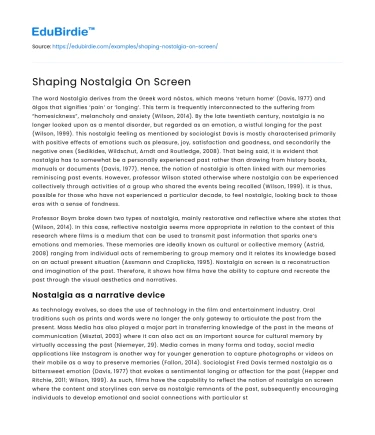The word Nostalgia derives from the Greek word nóstos, which means ‘return home’ (Davis, 1977) and álgos that signifies ‘pain’ or ‘longing’. This term is frequently interconnected to the suffering from “homesickness”, melancholy and anxiety (Wilson, 2014). By the late twentieth century, nostalgia is no longer looked upon as a mental disorder, but regarded as an emotion, a wistful longing for the past (Wilson, 1999). This nostalgic feeling as mentioned by sociologist Davis is mostly characterised primarily with positive effects of emotions such as pleasure, joy, satisfaction and goodness, and secondarily the negative ones (Sedikides, Wildschut, Arndt and Routledge, 2008). That being said, it is evident that nostalgia has to somewhat be a personally experienced past rather than drawing from history books, manuals or documents (Davis, 1977). Hence, the notion of nostalgia is often linked with our memories reminiscing past events. However, professor Wilson stated otherwise where nostalgia can be experienced collectively through activities of a group who shared the events being recalled (Wilson, 1999). It is thus, possible for those who have not experienced a particular decade, to feel nostalgic, looking back to those eras with a sense of fondness.
Professor Boym broke down two types of nostalgia, mainly restorative and reflective where she states that (Wilson, 2014). In this case, reflective nostalgia seems more appropriate in relation to the context of this research where films is a medium that can be used to transmit past information that sparks one’s emotions and memories. These memories are ideally known as cultural or collective memory (Astrid, 2008) ranging from individual acts of remembering to group memory and it relates its knowledge based on an actual present situation (Assmann and Czaplicka, 1995). Nostalgia on screen is a reconstruction and imagination of the past. Therefore, it shows how films have the ability to capture and recreate the past through the visual aesthetics and narratives.
Save your time!
We can take care of your essay
- Proper editing and formatting
- Free revision, title page, and bibliography
- Flexible prices and money-back guarantee
Nostalgia as a narrative device
As technology evolves, so does the use of technology in the film and entertainment industry. Oral traditions such as prints and words were no longer the only gateway to articulate the past from the present. Mass Media has also played a major part in transferring knowledge of the past in the means of communication (Misztal, 2003) where it can also act as an important source for cultural memory by virtually accessing the past (Niemeyer, 29). Media comes in many forms and today, social media applications like Instagram is another way for younger generation to capture photographs or videos on their mobile as a way to preserve memories (Fallon, 2014). Sociologist Fred Davis termed nostalgia as a bittersweet emotion (Davis, 1977) that evokes a sentimental longing or affection for the past (Hepper and Ritchie, 2011; Wilson, 1999). As such, films have the capability to reflect the notion of nostalgia on screen where the content and storylines can serve as nostalgic remnants of the past, subsequently encouraging individuals to develop emotional and social connections with particular stories or scenes. Film is often used to either preserve a certain memory, values or meanings that can be transported to the minds of the audience and be preserved in their memory (Sam Kim, Sean Kim and Petrick, 2017). These nostalgic experiences can then affect and stimulate either positive or negative feelings (Wilson, 1999).
Evoking authenticity in local films
Storytelling of Royston Tan’s 881 (2007). According to historian Prasenjit Duara, the images of authenticity can (Chong, 878) and is said to engage in a non-standardised positive image (Yoo-lee, Fowler, Adkins, Kim and Davis, 2014). In today’s context, authenticity in films does not mean questioning its original work of art, rather the relationship between reality and the content of a film (Skare, 2016). Most of Tan’s films address the problems of communication within Asian families, alienation as well as separation issues as a result of modernisation (Tan, 233; Liew and Teo, 28). 881 is an exemplification of showing how Chinese Singaporean directors disobeyed the government’s rule of making films only in the official language of Mandarin (Khoo and Metzger, 2009) by bringing back the exuberant real life of Singapore getai (song stage in English) scene that was held all around the city’s heartlands during the annual Chinese “Hungry Ghost Festival”. This nostalgic getai performance was once a live entertainment largely welcomed by the older generations in Singapore where it is no longer apparent and appreciated by the young today (Uhde and Ng, 150).
Tan’s 881 demonstrates the use of extravagant costumes alongside colourful makeshift stage sets that shows how the getai scene was like in the past. Hence, in a way discovering the golden age period of showing historical costume movies (Uhde and Ng, 74). Not only that, the film portrays the use of Mandarin language and Hokkien dialect, which are mainly the languages, used by the getai performers in the past. In 1979, the Singapore Government implemented the Speak Mandarin Campaign Language (SMC), where the use of Chinese dialect was banned in the broadcast mass media of film, radio and television (Silver and Bokhorst-Heng, 2017). The use of dialect shows how Tan is trying to challenge the language policy ever since the government launched the ‘Speak Mandarin Campaign’, as a result suppressing the use of dialects (Ng, 2014) for fear it results in a (Newman, 1988). Language in this sense is vital to bringing the significance of authenticity to the film (Uhde and Ng, 150) which comprises of cultural values (Yoo-lee, Fowler, Adkins, Kim and Davis, 2014). The notion of nostalgia, in this case, is being reflected through the way in which Tan portrays the forgotten culture and people through the narratives of this film.






 Stuck on your essay?
Stuck on your essay?

